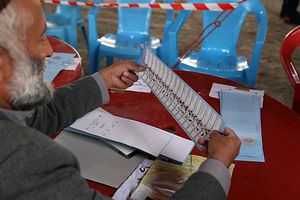On Sunday, current Afghan Chief Executive and presidential candidate Abdullah Abdullah withdrew his team’s election observers from an official recount of ballots following disputes over exactly which votes to count.
Abdullah called on the Independent Election Commission (IEC) to cease its recount of 8,255 polling stations. The core of Abdullah’s objection to the recount process is a dispute over what his team says are more than 300,000 “fraudulent votes.”
The 300,000 includes 137,630 votes quarantined by Dermalog’s servers due to “small mistakes.” Dermalog is the German company that provided the biometric technology used in the Afghan election. The rest consists of 102,012 votes reportedly cast outside of official polling hours, plus an unstated number of votes cast with duplicate photos or other irregularities.
Ali Yawar Adili and Jelena Bjelica wrote for the Afghanistan Analysts Network last week about the devilishly confusing and tumultuous array of turnout numbers that have been issued from various voices since the September 28 election.
From Adili and Bjelica:
Since election day on 28 September, the IEC has been struggling to determine turnout and has provided many conflicting figures without explanation. The highest turnout figure announced by the IEC was 2,695,890 votes. Compared to the latest, the 2 November figure of 1,843,107 votes, this could mean that as many as 852,783 votes have been invalidated… The IEC seems to be divided over whether to approve the latest Dermalog-vetted figure of 1,843,107 ‘whitelisted’ votes as the final BVVed [biometrically-verified-voter] votes.
More than 40 days after the pivotal presidential election, we’re still unsure how many votes were cast — not to mention who the victor is.
Abdullah said Sunday, “The vote should be clear before there is a recount.”
While Abdullah’s boycott of the recount hit headlines, his camp is not alone in its concerns about the process. According to TOLO News, in addition to Abdullah’s team, “the Council of Presidential Candidates – which includes 10 out of 18 presidential runners – also boycotted the vote recount process.”
The campaign team of current President Ashraf Ghani has lobbed accusations that Abdullah’s team is, as Adili and Bjelica explained, “trying to reduce the number of accepted votes in an attempt to push the election into a second round.”
The IEC is scheduled to released election results on November 14, but it looks probable that the date will be pushed back again. After the vote on September 28, preliminary results were supposed to be released by October 19. Chair of the IEC, Hawa Alam Nuristani, has pushed for patience. In late October she said, “We have already apologized for missing the date… but this doesn’t mean failure.”
“This [election] is a fate-determining issue in the country and we cannot accept sacrificing transparency for speed,” she said. At the time, various campaigns accepted the delay for the sake of transparency and accountability.
Nuristani is now urging protesting campaigns to allow the recount to proceed.
If no candidates secures more than 50 percent of the vote, the election will go into a second round.
In 2014, the Afghan presidential election went to a second round that saw Ghani and Abdullah face off directly. Although Abdullah secured more votes in the first round than Ghani, Ghani was declared the winner of the second round. Allegations of fraud flew freely and U.S. Secretary of State John Kerry jetted in to negotiate a settlement between the two political rivals. The resulting National Unity Government has struggled to stand united in the years since. The latest election looks likely to deliver an unfortunate repeat performance.

































